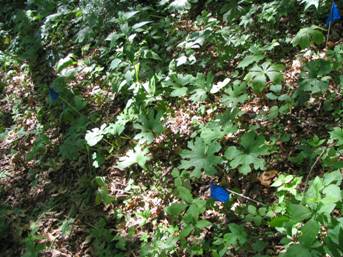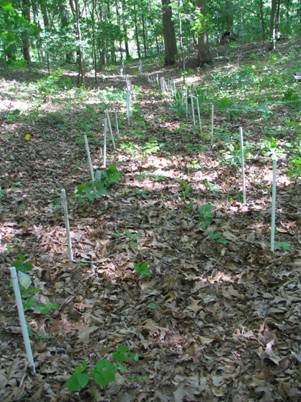Bloodroot Cultivation-2004 Report
go.ncsu.edu/readext?441663
en Español / em Português
El inglés es el idioma de control de esta página. En la medida en que haya algún conflicto entre la traducción al inglés y la traducción, el inglés prevalece.
Al hacer clic en el enlace de traducción se activa un servicio de traducción gratuito para convertir la página al español. Al igual que con cualquier traducción por Internet, la conversión no es sensible al contexto y puede que no traduzca el texto en su significado original. NC State Extension no garantiza la exactitud del texto traducido. Por favor, tenga en cuenta que algunas aplicaciones y/o servicios pueden no funcionar como se espera cuando se traducen.
Português
Inglês é o idioma de controle desta página. Na medida que haja algum conflito entre o texto original em Inglês e a tradução, o Inglês prevalece.
Ao clicar no link de tradução, um serviço gratuito de tradução será ativado para converter a página para o Português. Como em qualquer tradução pela internet, a conversão não é sensivel ao contexto e pode não ocorrer a tradução para o significado orginal. O serviço de Extensão da Carolina do Norte (NC State Extension) não garante a exatidão do texto traduzido. Por favor, observe que algumas funções ou serviços podem não funcionar como esperado após a tradução.
English
English is the controlling language of this page. To the extent there is any conflict between the English text and the translation, English controls.
Clicking on the translation link activates a free translation service to convert the page to Spanish. As with any Internet translation, the conversion is not context-sensitive and may not translate the text to its original meaning. NC State Extension does not guarantee the accuracy of the translated text. Please note that some applications and/or services may not function as expected when translated.
Collapse ▲This is a 2004 report from a NC Specialty Crops Program Project. It is posted for historical reference purposes.
PROJECT LEADER(S): Jeanine M. Davis
LOCATION: Mountain Horticultural Crops Research Station, Fletcher and Mountain Research Station, Waynesville.
IMPACT
Currently there are at least 25 bloodroot growers in western North Carolina. These are new plantings and will not be ready for harvest for several more years. There is a projected need by one company for at least 300,000 pounds of dried root per year. It will take hundreds of acres to satisfy that kind of demand. Presently, there are probably less than 70 acres in production in all of North America. Preliminary enterprise budgets indicate that at current prices a grower could expect to net $1,210 per acre after three years. Prices for cultivated bloodroot should rise, however, as wild-harvested material becomes harder to obtain.
INTRODUCTION: Bloodroot (Sanguinaria canadensis) is a native medicinal plant that grows in eastern hardwood forests. It is wild harvested for use in production of several new products. To help conserve native populations and provide a new economic opportunity for forest land owners, research on a commercial cultivation system is being developed. Studies are being conducted at several wooded locations in western North Carolina and under a polypropylene shade structure. Cooperators on these projects include graduate student, Maria Onofrietti, researcher, David Danehower, and technician Agatha Kaplan from N.C. State University and Nick Oberlies from Research Triangle Institute.
METHODS:
Propagation:
This study was established in the fall of 2001 to determine what part of the rhizome can be used for propagation and how long it must be grown to reach an economically feasible size for harvest. The experiment is duplicated in the woods and under a polypropylene shade cloth structure. Propagule treatments were either small whole rhizomes, rhizome pieces with buds, or rhizome pieces without any obvious buds. The plots will be harvested after 2, 4, and 6 years of growth.
Companion Planting:
In this study, established in the fall of 2002, we are examining the influence of companion plants on growth and yield of bloodroot. Bloodroot is being grown in forest beds either alone, with mayapple, or with goldenseal. This study will be harvested after 1, 3, and 5 years of growth.
Tillage Systems:
In this study, established in the fall of 2002, the response of bloodroot growth and yield to various tillage systems is being examined. Bloodroot was planted in two locations in the woods in raised beds, strip-tilled plots, or no-till plots. These plots will be dug after 1, 3, and 5 years of growth.
Results:
Propagation:
The first harvest, after two years of growth, took place in fall of 2003. Rhizome/root growth was much greater under artificial shade than in a natural wooded setting; 4 to 30 times greater, depending on the treatment. In both fields, the absence of a bud on the propagule slowed rhizome/root growth considerably. The rhizomes were not ready for commercial harvest after two years.
In 2004, under the artificial shade structure, 67% of the plots had 90% or more emergence. These were evenly distributed among the three treatments. In the woods, survival was much less. Only 13% of the plots had at least 90% survival and 25% of the plots had no plants growing at all. There were no differences among treatments.
Companion Planting:
The first harvest took place in fall of 2003. All treatments exhibited a reduction in rhizome/root weight after just one year of growth. The greatest decrease was observed in the bloodroot with black cohosh treatment. The smallest decrease occurred in the bloodroot alone treatment.
In 2004, there was no root harvest so all data were collected on growth of above ground plant parts. One hundred percent emergence occurred only in the plots where bloodroot was grown with black cohosh, goldenseal, or mayapple. Five of the eight bloodroot alone plots had no plant emergence at all.
Tillage Systems:
The first harvest was in 2003. After one year of growth there were no differences observed in growth or root yield.
In 2004, at Waynesville, the highest number of plots with 90% emergence or more were strip-tilled. The two plots with no bloodroot emergence were both bedded plots. In contrast, at Fletcher, the bedded plots were the ones that most frequently had emergence of 90% or more, but there were 11 plots with no bloodroot emergence and they were evenly split among the three treatments.
Conclusions:
These studies will not be completed for several more years. However, at this time we are suggesting that growers consider growing bloodroot with a companion plant, such as black cohosh; consider growing in raised beds or a strip-till system; and consider growing under artificial shade.
TABLES & PHOTOS
Posted by Jeanine Davis, NC Alternative Crops & Organics Program, Department of Horticultural Science, NC State University (Reviewed 7/15/2022)




